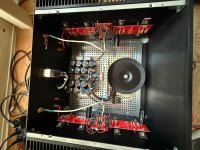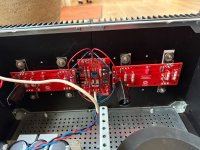Toxic Vinyl...Hmm. Havent heard that one before. How do you even exist with the 1000s of chemicals you are surrounded by everyday.
Another note. If you use switchers you cant just load them down with a capacitive load. They tend not to start up. Right now I'm not using anything between the SPS and the boards. Maybe before final build.
Another note. If you use switchers you cant just load them down with a capacitive load. They tend not to start up. Right now I'm not using anything between the SPS and the boards. Maybe before final build.
You gotta detox. Once or a few times per year do a few weeks of cleansing, go to sauna often, diet, fasting, many things you can do to reduce the industrial pollutants in the body.
Vynil like many other polymers breaks down to shorter chains over time and you may know this, the individual molecules of vinyl chloride are actually volatile enough to evaporate into the air. But it's just a substance that's hard to dispose of. So I don't think you really want to support that industry necessarily. On the other hand we all drive huge chunks of plastics called cars, so I don't know, but definitely worth removing it from the body as much as possible or at least limiting exposure.
I think good ones like Meanwell have startup current limiters or something like that. And ultimately, I will be using 0.2R or even thermistors before the big caps.
Vynil like many other polymers breaks down to shorter chains over time and you may know this, the individual molecules of vinyl chloride are actually volatile enough to evaporate into the air. But it's just a substance that's hard to dispose of. So I don't think you really want to support that industry necessarily. On the other hand we all drive huge chunks of plastics called cars, so I don't know, but definitely worth removing it from the body as much as possible or at least limiting exposure.
I think good ones like Meanwell have startup current limiters or something like that. And ultimately, I will be using 0.2R or even thermistors before the big caps.
Last edited:
Oh ok. Haven't heard of thermistors before caps. I could see that working. Is that something that others are doing. Yeah your right about VC. I used to work for 20 years at a factory that processed PVC day and night. Even stuff that would melt and put out fumes. Probably lucky to be here.
Well, among my LPs, I have a significant number of records that are between 50 and 70 years old. They haven't turned brittle or otherwise changed yet. Can't be that much evaporation from records ...
Also, most of my records I have bought used ... that is not as bad for the environment as manufacturing new ones ...
Regards, Claas
Also, most of my records I have bought used ... that is not as bad for the environment as manufacturing new ones ...
Regards, Claas
Too bad. New Vinyl sounds better than ever. Quiet surfaces, heavy weights. Much better than the 70's and 80's. Now the prices are TOO high, give you that.
HelloI have a hard time measuring the thermistors, the resistance varies with ambient temperature. The schematic calls for 4.7K ohm NTC, I used the ones made by vishay.
Use the diode function on your meter to test the MOSFET's, google how to test MOSFET's using a DVOM for results.
I exchanged the jfets for new ones and now the f5 is running again.
Thank you for your help.
I have a question about the Poti 3 and its effects.
What experiences have you had with it or Which settings make sense?
Greetings
Torsten
Hello Torsten,
Which JFETs and from which supplier did you get? Did you notice any differences between them and the original soundwise?
On a separate note:
Could anyone check out this SMPS and confirm that it's good to use for F5m? I can get a few for very cheap, so I'd be using two in series for ± 24V rails. Should I pay specific attention to the switching frequency or can that be filtered regardless of what it is?
https://eu.mouser.com/datasheet/2/260/MWEC_S_A0007326977_1-2552144.pdf
Which JFETs and from which supplier did you get? Did you notice any differences between them and the original soundwise?
On a separate note:
Could anyone check out this SMPS and confirm that it's good to use for F5m? I can get a few for very cheap, so I'd be using two in series for ± 24V rails. Should I pay specific attention to the switching frequency or can that be filtered regardless of what it is?
https://eu.mouser.com/datasheet/2/260/MWEC_S_A0007326977_1-2552144.pdf
Attachments
Last edited:
Hello Billhoerst / Torsten,
starting point with Pot3 is midposition. You can count the turns from fully left /counterclockwise to fully right / clockwise and
adjust it to the mid. More accurate is to measure the resistance of Pot 3. Can be done before soldering it into the frontend of the F5T.
The balance between the N-channel JFet and the P-channel JFet is a question of taste.Don't adjust Pot 3 to the extremes.
Don't do this during operation - music listening!!!
No speaker should be at the output. And a sine wave generator at the input of your F5T. Be careful that your DC-offset at
loudspeaker -output is not running away (keep below 50mV - lower is better).
Don't expect a completely different sounding amp from this procedure. And you should have an oscilloscope to do it right.
Another possibility is to use REW and an A/D-converter (many use the focusrite Scarlet), feed an 1 kHz sinewave to the input of the amp and measure the H2 / H3-profile. You will also need power-resistors at the speakeroutput of your amp to measure this. Many search for a slightly higher 2nd harmonic distortion than 3rd harmonic distortion.
Only some thoughts
Dirk
starting point with Pot3 is midposition. You can count the turns from fully left /counterclockwise to fully right / clockwise and
adjust it to the mid. More accurate is to measure the resistance of Pot 3. Can be done before soldering it into the frontend of the F5T.
The balance between the N-channel JFet and the P-channel JFet is a question of taste.Don't adjust Pot 3 to the extremes.
Don't do this during operation - music listening!!!
No speaker should be at the output. And a sine wave generator at the input of your F5T. Be careful that your DC-offset at
loudspeaker -output is not running away (keep below 50mV - lower is better).
Don't expect a completely different sounding amp from this procedure. And you should have an oscilloscope to do it right.
Another possibility is to use REW and an A/D-converter (many use the focusrite Scarlet), feed an 1 kHz sinewave to the input of the amp and measure the H2 / H3-profile. You will also need power-resistors at the speakeroutput of your amp to measure this. Many search for a slightly higher 2nd harmonic distortion than 3rd harmonic distortion.
Only some thoughts
Dirk
Well, I found they are 100 kHz (typical for Meanwell although some have even lower). Have anyone used an SMPS with switching frequency this close to audible frequencies and had success in terms of eliminating all noise? I use headphones, so it's pretty important to me.Could anyone check out this SMPS and confirm that it's good to use for F5m?
https://eu.mouser.com/datasheet/2/260/MWEC_S_A0007326977_1-2552144.pdf
I have a question about the Poti 3 and its effects.
I agree with cubicincher 100%, I have found the midway point of P3 works very well. This is such a fine sounding amp that P3 adjustment is very fine tuning of an excellent sounding amp.
helloHello Torsten,
Which JFETs and from which supplier did you get? Did you notice any differences between them and the original soundwise?
On a separate note:
Could anyone check out this SMPS and confirm that it's good to use for F5m? I can get a few for very cheap, so I'd be using two in series for ± 24V rails. Should I pay specific attention to the switching frequency or can that be filtered regardless of what it is?
https://eu.mouser.com/datasheet/2/260/MWEC_S_A0007326977_1-2552144.pdf
I bought the jfets in the diy-store
https://diyaudiostore.com/
I found 350mV bias with the diodes is on the edge, I prefer 300 - 320mV, although many say higher bias sounds better.
You have the thermisters touching the metal washer on your MOSFET's, they only have a thin coating of paint on them and are known to cause issues. Move them so they touch the plastic case of the MOSFET's, see if that helps the channel come back to life.
One last thing, if you have no input, then no load is OK. Whenever I have an input, I make sure to have an 8 ohm load connected to the speaker terminals.
Hello
After installing the new Jfets, I can not set the bias on the repaired side higher than 325mV. On the other side of the amplifier, the setting continues to go up to 350 mV and higher. What to do?
Did you replace all the JFET's or just on the "bad" channel?What to do?
Can you measure the temperature of the heatsinks for each channel after at least 30 minutes of being on, inputs shorted?
When I originally developed mine 3 years back I had the same problem. I had to drop the emitter resistors from 1ohm to two in parallel or .5 ohm and then I could raise my bias. But did you change the front end fees just on 1 board? If so I would change on the other also so sides are matched to start with. Then you can do the same thing with both boards to get bias up. But see what ZM says first
Hello
I only exchanged the jfets of the bad side with the Toshiba from the diy store 6-8 mA.
I made the following measurements:
I let the amplifier run for 30 minutes in the closed state. Then I opened the amplifier and immediately measured the bias. It was on both sides at about 350 mV.
The temperature of the heat sinks directly between mosfets is after 30 minutes approx. 43 degrees Celsius measured inside on both sides
10 minutes after opening, the bias dropped on the repaired side to 330mV and on the other side the bias remained at 350mV.
The offset remained at about 0 at the output.
@zm : What exactly should I send. I didn't understand it.
I only exchanged the jfets of the bad side with the Toshiba from the diy store 6-8 mA.
I made the following measurements:
I let the amplifier run for 30 minutes in the closed state. Then I opened the amplifier and immediately measured the bias. It was on both sides at about 350 mV.
The temperature of the heat sinks directly between mosfets is after 30 minutes approx. 43 degrees Celsius measured inside on both sides
10 minutes after opening, the bias dropped on the repaired side to 330mV and on the other side the bias remained at 350mV.
The offset remained at about 0 at the output.
@zm : What exactly should I send. I didn't understand it.
schm of amp you're usingWhat exactly should I send. I didn't understand it.
so I can tell you exactly and clearly what to do
- Home
- Amplifiers
- Pass Labs
- F5 Turbo Builders Thread


